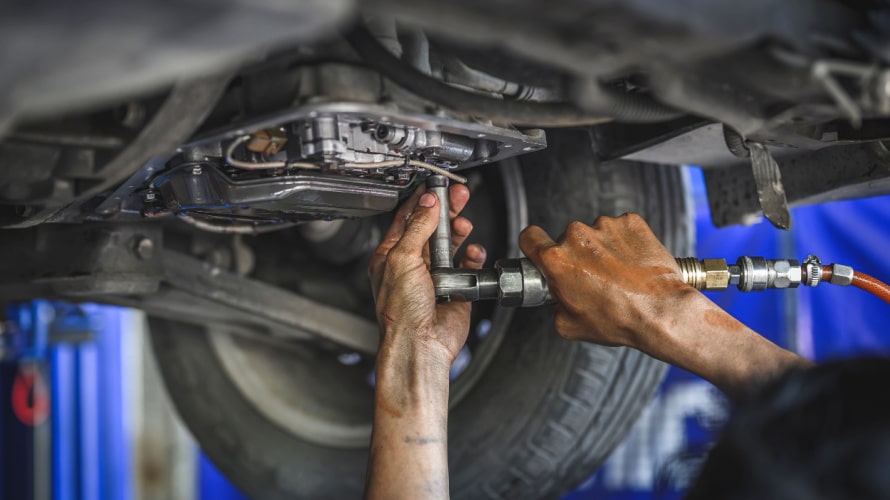Transmission 101: Understanding Common Issues And Solutions
September 21, 2023
Tires

The transmission is an essential part of your car that helps you shift gears, control speed, and keep the wheels spinning. You might not be a car expert, but don’t worry – TIRECRAFT has your back. We’ll break down transmission problems in relation to winter tires, what causes them, and how to deal with them for you.
Let’s understand the relationship between transmission and winter tires. Also known as snow tires, winter tires are specifically designed to provide better traction and performance in cold weather conditions, especially on snow and ice. The role of the transmission in conjunction with winter tires is important for optimizing the vehicle’s performance and safety during winter driving.
Learn How The Transmission Interacts With Winter Tires:
Traction And Power Distribution
The transmission plays a crucial role in distributing the engine’s power to the wheels. In many vehicles, power is sent to either the front wheels, rear wheels, or all four wheels, depending on the transmission configuration.
Gearing
The transmission controls the vehicle’s gearing. In certain situations, you may need to adjust your driving style or the transmission’s gear selection to optimize traction and control.
Engine Braking
On slippery roads, you may need to slow down or stop more gradually to avoid skidding. Engine braking is achieved by downshifting the transmission and can help in such situations.
Controlled Acceleration
Winter driving often requires smooth and controlled acceleration to prevent wheel spin. An automatic transmission can sometimes be less intuitive in these situations and in such cases, you may need to use the transmission’s manual mode to select gears manually.
Vehicle Stability Control
Many modern vehicles have stability control systems that work in conjunction with the transmission and brakes to prevent skidding. These systems can modulate power and braking to specific wheels, and they can be especially useful when combined with winter tires.
Common Issues And Solutions When It Comes To Transmission And Winter Tires:
Increased Rolling Resistance:
Winter tires often have deeper treads and a more aggressive tread pattern to grip snow and ice. This can lead to increased rolling resistance, which affects fuel efficiency and may strain the transmission. A solution for this is to make sure your winter tires are properly inflated and consider switching back to your regular tires once winter conditions have passed to improve fuel economy.
Sluggish Acceleration
Winter tires can reduce acceleration performance due to their softer rubber compound and deep treads, which can result in slower acceleration. A solution for this if you find that your vehicle’s acceleration is significantly affected, consider using a lower gear or manually shifting in automatic transmissions.
Transmission Overheating
In very slippery conditions, you might be inclined to overwork the transmission by revving the engine to gain traction, which can lead to transmission overheating. A resolution for is to be gentle with the accelerator pedal and avoid excessive revving. If you’re stuck, try rocking the vehicle back and forth in a lower gear rather than revving the engine constantly.
Reduced Fuel Efficiency
Winter tires can decrease fuel efficiency due to their higher rolling resistance and the need for more power to overcome slippery conditions. A solution for this is to drive more conservatively and maintain proper tire pressure. Reducing speed and planning your trips can help mitigate the decrease in fuel efficiency.
Maintenance And Storage
If winter tires are not stored properly during the offseason, they can deteriorate or become less effective in subsequent winters. A resolution for this is to store the tires in a cool, dry place away from direct sunlight. Ensure they are properly cleaned before storage, and check their pressure periodically.
Transmission Wear
Repeated harsh driving conditions with winter tires can contribute to increased wear and tear on the transmission over time. A solution for this is to drive gently and ensure your transmission is properly maintained with regular fluid changes and inspections.
At TIRECRAFT, we understand your car’s transmission and preventing common issues, which are vital for maintaining your vehicle’s performance and longevity. Ensuring you keep your transmission maintained means it’ll keep you on the road safely and functioning properly for a long time coming.
We’re not just about tires; we’re about keeping you informed and helping you take care of your car. If you have any transmission-related questions or need professional advice, don’t hesitate to reach out to your nearest Tirecraft location using our ‘Find a TIRECRAFT’ tool. We’re here to keep things rolling smoothly.
Back

